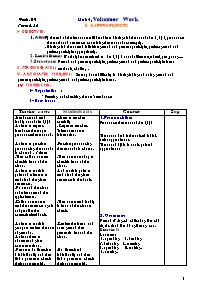Bài soạn môn học Tiếng Anh 11 - Period 26 - Unit 4: Volunteer work E - Language focus

I- objectives:
1. Aim:By the end of the lesson sts will be able to distinguish the sounds / w / , / j /, pronounce the words and sentences containing these sounds correcytly.
- Distinguish the uses of infinitive gerund and present participle, perfect gerund and perfect participle appropriately.
2. Lexical items: Words/ phrases related to / w /, / j / sounds like: we, wheel, yes, young.
3. Structures: Gerund and present participle, perfect gerund and perfect participle forms
II. Teaching aids: textbook, chalks,
III. Anticipated problems: Sts may have difficulty in distingishing and using gerund and present participle, perfect gerund and perfect participle forms.
IV- Procedures:
1- Organization:
- Greeting and checking the sts’ attendance
2- New lesson
Week: 09 Unit 4: Volunteer Work Period: 26 e - language focus I- objectives: 1. Aim:By the end of the lesson sts will be able to distinguish the sounds / w / , / j /, pronounce the words and sentences containing these sounds correcytly. - Distinguish the uses of infinitive gerund and present participle, perfect gerund and perfect participle appropriately. 2. Lexical items: Words/ phrases related to / w /, / j / sounds like: we, wheel, yes, young.... 3. Structures: Gerund and present participle, perfect gerund and perfect participle forms II. Teaching aids: textbook, chalks, III. Anticipated problems: Sts may have difficulty in distingishing and using gerund and present participle, perfect gerund and perfect participle forms. IV- Procedures: 1- Organization: - Greeting and checking the sts’ attendance 2- New lesson Teacher’ s acts Students’ acts Content Sup -Introduce and read loudly sounds/ w /,/ j / -Ask sts to repeat. Introduce the way to pronounce these sound. -Ask sts to practise pronouncing the sounds in chorus 2 - 3 times -Then call on some to check in front of the class. -Ask sts to work in pairs and take turn to read aloud the given sentences . -Go around the class and take notes of the typical errors. -Call on some sts to read the sentences again and provide the corrective feedback. -Ask sts to work in groups to review the use of gerunds. -Ask anothers to observe and give commentations. -Get sts to do Exercise 1 individually and then find a partner to check their answers with. -Call on some sts to read their answers in front of the class. -Then check with the whole class and provide corrective feedback. -Ask sts to review the forms of present participles its uses in groups . -Listen and conclude again to make sts more clearly. -Then get sts to do exercise 2 indidually and then find a partner to check their answers with. -T checks with the whole class and provides corrective feedback. -Aks sts to revise the forms and uses of perfect gerund, and perfect participles. -Call on some sts to present infront of the class. Listen and emphasize the uses of perfect gerund and participle. -Then get sts to do exercise individually and then compare the answers with a partner. -Call on some read their answers in front of the class to check on the whole. -After that T provides the corrective feedback. guides sts do homework -Listen to teacher carefully - Repeat to teacher. Takes note some information. -Practise pronouncing these sounds in chorus. -Then some stand up to check in front of the class. -And work in pairs to read aloud the given sentences in the book. -Then some read loudly in front of the class to check. -Review the forms and uses gerund then present in front of the class. -Do Exercise 1 individually and then find a partner to check their answers with. -Read the answers in front of the class. -Review the forms of of present participles its uses in groups . Some present in front of the class. --Do exercise 2 indidually and then find a partner to check their answers with. -revise the forms and uses of perfect gerund, and perfect participles in groups. -Some present in front of the class. -Do exercise individually and then compare the answers with a partner. -Some read the answers in front of the class to check on the whole. Take notes. 1.Pronunciation: Pronounce these sound. / w /,/ j / The souns / w / is the voiced labial-velar approximant. The sound / j/ is is a voic palatal approximant 2. Grammar : Gerund :V-ing.cã chøc n¨ng lµm chñ tõ, tóc tõ vµ lµm bæ ng÷ trong c©u. Exercise 1: Answers: 1. spending 2. bending 3. behaving 4. meeting 5. spending 6. waiting. 7. starting. Exercise 2: Present participle: V-ing Dïng ®Ó diÔn t¶ ho¹t ®éng ®ang diÔn ra. -Trong c¸c th× tiÕp diÔn -dïng rót ng¾n mÖnh ®Ò cã nhiÒu ho¹t ®éng cña cïng 1 chñ tõ . -Dïng sau c¸c ®éng tõ chØ gi¸c quan :see, hear, smell, stast . -Dïng sau ®éng tõ “go” Answers : 1. burning/ rising 2. reading 3. lying. 4. shopping 5. preparing 6. trying. 7. mordernizing. Exercise 3: Perfect gerund and perfect participle - Perfect gerund ®îc dïng thay cho d¹ng hiÖn t¹i cña danh ®éng tõkhi chóng ®Ò cËp tíi hµnh ®éng trong qu¸ khø. - Perfect gerund têng dïng sau “DENY” -perfect participle dïng ®Ó nhÊn m¹nh hµnh ®éng vµ ®· hoµn tÊt tríc mét hµnh déng kh¸c trong qu¸ khø. Answers: 1. having 2. having been 3. having been. 4. having tired 5. having read 6. having taken. 5. Homework: exercises in languge focus at 28,29,30 pages.) Do again these exercises.
Tài liệu đính kèm:
 Av11(T26).doc
Av11(T26).doc





